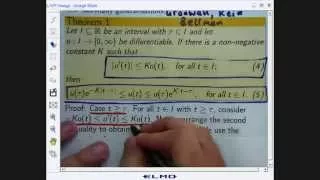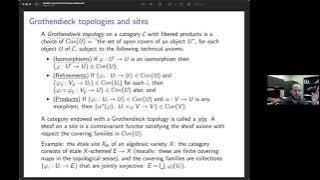Differential topology
In mathematics, differential topology is the field dealing with the topological properties and smooth properties of smooth manifolds. In this sense differential topology is distinct from the closely related field of differential geometry, which concerns the geometric properties of smooth manifolds, including notions of size, distance, and rigid shape. By comparison differential topology is concerned with coarser properties, such as the number of holes in a manifold, its homotopy type, or the structure of its diffeomorphism group. Because many of these coarser properties may be captured algebraically, differential topology has strong links to algebraic topology. The central goal of the field of differential topology is the classification of all smooth manifolds up to diffeomorphism. Since dimension is an invariant of smooth manifolds up to diffeomorphism type, this classification is often studied by classifying the (connected) manifolds in each dimension separately: * In dimension 1, the only smooth manifolds up to diffeomorphism are the circle, the real number line, and allowing a boundary, the half-closed interval and fully closed interval . * In dimension 2, every closed surface is classified up to diffeomorphism by its genus, the number of holes (or equivalently its Euler characteristic), and whether or not it is orientable. This is the famous classification of closed surfaces. Already in dimension two the classification of non-compact surfaces becomes difficult, due to the existence of exotic spaces such as Jacob's ladder. * In dimension 3, William Thurston's geometrization conjecture, proven by Grigori Perelman, gives a partial classification of compact three-manifolds. Included in this theorem is the Poincaré conjecture, which states that any closed, simply connected three-manifold is homeomorphic (and in fact diffeomorphic) to the 3-sphere. Beginning in dimension 4, the classification becomes much more difficult for two reasons. Firstly, every finitely presented group appears as the fundamental group of some 4-manifold, and since the fundamental group is a diffeomorphism invariant, this makes the classification of 4-manifolds at least as difficult as the classification of finitely presented groups. By the word problem for groups, which is equivalent to the halting problem, it is impossible to classify such groups, so a full topological classification is impossible. Secondly, beginning in dimension four it is possible to have smooth manifolds that are homeomorphic, but with distinct, non-diffeomorphic smooth structures. This is true even for the Euclidean space , which admits many exotic structures. This means that the study of differential topology in dimensions 4 and higher must use tools genuinely outside the realm of the regular continuous topology of topological manifolds. One of the central open problems in differential topology is the four-dimensional smooth Poincaré conjecture, which asks if every smooth 4-manifold that is homeomorphic to the 4-sphere, is also diffeomorphic to it. That is, does the 4-sphere admit only one smooth structure? This conjecture is true in dimensions 1, 2, and 3, by the above classification results, but is known to be false in dimension 7 due to the Milnor spheres. Important tools in studying the differential topology of smooth manifolds include the construction of smooth topological invariants of such manifolds, such as de Rham cohomology or the intersection form, as well as smoothable topological constructions, such as smooth surgery theory or the construction of cobordisms. Morse theory is an important tool which studies smooth manifolds by considering the critical points of differentiable functions on the manifold, demonstrating how the smooth structure of the manifold enters into the set of tools available. Often times more geometric or analytical techniques may be used, by equipping a smooth manifold with a Riemannian metric or by studying a differential equation on it. Care must be taken to ensure that the resulting information is insensitive to this choice of extra structure, and so genuinely reflects only the topological properties of the underlying smooth manifold. For example, the Hodge theorem provides a geometric and analytical interpretation of the de Rham cohomology, and gauge theory was used by Simon Donaldson to prove facts about the intersection form of simply connected 4-manifolds. In some cases techniques from contemporary physics may appear, such as topological quantum field theory, which can be used to compute topological invariants of smooth spaces. Famous theorems in differential topology include the Whitney embedding theorem, the hairy ball theorem, the Hopf theorem, the Poincaré–Hopf theorem, Donaldson's theorem, and the Poincaré conjecture. (Wikipedia).




















